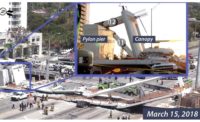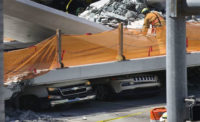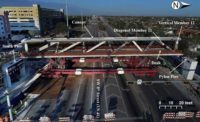During its three-hour-plus-long presentation on the cause of the Florida International University pedestrian bridge collapse, officials with the National Transportation Safety Board referred to its roughly 18-month-long investigation as one of its most complex.
NTSB Chairman Robert Sumwalt noted that he’s been on the safety board for 13 years and deliberated over nearly 200 accidents. He said, “I don’t think I’ve ever seen one where there’s more finger-pointing between the parties. And you know, the finger-pointing is actually correct. Everybody’s pointing at everyone else. In fact, that is correct—because everyone shares a piece of this accident. There were errors up and down the line.”.
As part of its Oct. 22 presentation into the bridge collapse’s probable cause, the NTSB listed 30 findings from its investigation. The findings are included as part of the NTSB’s abstract report, the full version of which readers can find here.
As the agency notes in its abstract, “The final report and pertinent safety recommendation letters will be distributed to recommendation recipients as soon as possible. The attached information is subject to further review and editing to reflect changes adopted during the Board meeting.”
Due to the list of findings' length, for our readers’ convenience—and to invite possible reader comment and discussion—ENR is publishing all of these findings here, in their entirety, without editing.
Findings
1. The emergency response by local fire departments and law enforcement personnel was timely and adequate.
2. The concrete and steel materials used during construction of the pedestrian bridge were not a factor in its collapse.
3. The hydraulic jack used to post-tension the steel rods in member 11 was operating as expected at the time of the bridge collapse.
4. (1) The FIGG Bridge Engineers (FIGG) bridge design was nonredundant because it provided only a singular load path, (2) FIGG used poor judgment when it determined the bridge was a redundant structure, and then, (3) FIGG erroneously used a redundancy factor of 1.0, which is commonly used for structures with redundant load paths.
5. Even if the cold joint surface of nodal region 11/12 had been roughened to a 0.25-inch amplitude, node 11/12 would not have had sufficient capacity to counteract the demand load for interface shear—and the bridge would still have been under-designed and could have failed.
6. The FIGG Bridge Engineers construction plans inconsistently identified when intentionally roughened surfaces were needed to fulfill the assumptions of the bridge design.
7. Because FIGG Bridge Engineers (1) did not use the lower bound load factor for determining the governing net compression, Pc, in the interface shear; and (2) incorrectly increased and amplified the effects of the clamping force across the interface shear surface, its bridge design calculations resulted in a significant overestimation of capacity.
8. FIGG Bridge Engineers (1) made significant design errors in the determination of loads, leading to a severe underestimation of the demands placed on critical portions of the pedestrian bridge; and (2) significantly overestimated the capacity of the member 1/2 and 11/12 nodal regions.
9. Based on analytical modeling results, FIGG Bridge Engineers should have considered the loadings from all critical construction stages when designing the pedestrian bridge and determining the governing interface shear demands.
10. In several instances throughout the bridge design process, the FIGG Bridge Engineers models produced reasonable estimations for interface shear demand, but these values were not always used in the design of truss members to resist force demands.
11. FIGG Bridge Engineers’ analytical modeling for the bridge design resulted in a significant underestimation of demand at critical and highly loaded nodal regions.
12. The concrete distress initially observed in nodal region 11/12 is consistent with the underestimation of interface shear demand and the overestimation of identified capacity in the bridge design.
13. The FIGG Bridge Engineers design of the rebar placement in node 11/12 resulted in less reinforcing steel being available and diminished resistance to the critical interface shear demand, which contributed to the collapse of the bridge.
14. The member 11/12 nodal region contained nonstructural voids (four hollow vertical pipe sleeves and the horizontal drain pipe) within the concrete that made it less able to resist applied loads, which contributed to the destabilization of this node through overstress and the subsequent collapse of the main span.
15. Although it may be generally accepted that concrete itself is susceptible to cracking, the rate of premature concrete distress was clear evidence that the structure was progressing toward failure and should have alerted FIGG Bridge Engineers and MCM to the origin of the distress mechanism that was causing the cracking and the rapidity of cracking progression.
16. Louis Berger was not qualified by the Florida Department of Transportation to conduct an independent peer review and failed to perform an adequate review of the FIGG Bridge Engineers design plans and to recognize the significant under-design of the steel reinforcement within the 11/12 node, which was unable to resist the horizontal shear between diagonal 11 and the bridge deck.
17. FIGG Bridge Engineers’ failure to adhere to the Florida Department of Transportation Plans Preparation Manual requirements for a complex category 2 bridge structure within its work proposal to MCM, calling for an independent firm to conduct a comprehensive peer review, led to the inadequate peer review performed by Louis Berger, which failed to detect the under-design of the bridge.
18. Had the Florida Department of Transportation Plans Preparation Manual called for all nodal forces of category 2 bridge structures to be checked and verified by a qualified independent peer review, this collapse might have been prevented.
19. As part of its oversight of local agency program projects and new construction, the Florida Department of Transportation should have verified Louis Berger’s qualifications as an independent peer review firm for complex bridge design–concrete upon receiving the 100 percent certification letters for the bridge foundation, substructure, and superstructure plans.
20. FIGG Bridge Engineers did not perform its due diligence when it contracted with Louis Berger for the independent peer review of the highly complex and uncommon concrete bridge design.
21. The restressing of member 11 was a manipulation of loads that constituted a change to the FIGG Bridge Engineers design, and, before being implemented, should have been independently peer reviewed and signed and sealed by a professional engineer.
22. The structural cracking and northward dislocation of the upper part of the member 11/12 nodal region, as documented in the days leading up to the collapse, was strong evidence that the structure was progressing toward failure; and the detensioning of the 5 post-tensioning rods located in member 11 significantly increased the damage to the member 11/12 nodal region.
23. Although the FIGG Bridge Engineers engineer of record and design manager were engaged by MCM to assess the increased cracking of the structure, they neither recognized that the singular load path in this nonredundant bridge had been compromised nor took appropriate action to mitigate the risk of failure.
24. Beginning with the cracking identified on February 24, 2018, the distress in the main span structure was active, continued to grow, and was well documented by all parties involved in the design, construction, and oversight of the bridge.
25. Neither Florida International University, MCM, FIGG Bridge Engineers, nor Bolton, Perez and Associates Consulting Engineers took the responsibility for declaring that the cracks were beyond any level of acceptability and did not meet Florida Department of Transportation standards.
26. Under the terms and conditions of the contract, Bolton, Perez and Associates Consulting Engineers had the authority to direct or authorize partial or complete road closures as necessary, acting in concert with the Florida Department of Transportation and Florida International University; however, none acted to close the road under the bridge, contributing to the severity of the impact of the bridge collapse.
27. Local agency program agreements require stronger language to clarify that the certified local agency has the authority to immediately close a bridge when structural cracks are first detected or in situations that require further investigation to protect the health, safety, and welfare of the public.
28. Given the pedestrian bridge’s unique, nonredundant design, the Florida Department of Transportation should have ensured that the local agencies involved in the project had adequate staff who were trained and experienced in administering these types of uncommon bridge designs.
29. The Florida Department of Transportation should have provided greater oversight of this complex local agency program project to ensure that all safety issues were identified and addressed.
30. Given the serious consequences of the error made by FIGG Bridge Engineers in assuming that the bridge had a redundant design, when it did not, and the current lack of guidance concerning redundancy design in concrete and pedestrian bridges, design specification publications for concrete and pedestrian bridges should be revised to include redundancy guidance.







Post a comment to this article
Report Abusive Comment